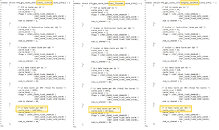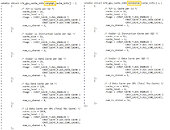Tuesday, March 30th 2021

AMD Outs 32 MB Infinity Cache on Navi 23, No Cache on Upcoming Van Gogh APUs
AMD has revealed the Infinity Cache size for the upcoming Navi 23 GPU, as well as its absence in the next-generation Van Gogh APU, which features Zen 2 cores and an RDNA GPU. The reveal comes via a new patch done by AMD to the AMKFD, a Linux kernel HSA driver for AMD APUs. The patch file doesn't list Infinity Cache per se, but does clarify the last-level cache for AMD's GPUs - L3, which is essentially the same.
The patch reveals L3 size for Sienna Cichlid (Navi 21), Navy Flounder (Navi 22), and Dimgrey Cavefish (Navi 23). Navi 21 features 128*1024 (128 MB) of Infinity Cache, the just-released Navi 22 has 96 MB, as we know, and according to the file, Navi 23 is bound to feature 32 MB of it. Considering that Van Gogh lacks an infinity Cache, it would seem that it's making use of previous-gen Navi graphics, and won't leverage RDNA2, of which the Infinity Cache is a big part of. It remains to be seen if Van Gogh will materialize in an APU product lineup or if it's a specific part for a customer. It also remains to be seen which RX product will Navi 23 power - if an AMD RX 66000 series, or 6500 series.
Sources:
Free Desktop Linux Patch, via Videocardz
The patch reveals L3 size for Sienna Cichlid (Navi 21), Navy Flounder (Navi 22), and Dimgrey Cavefish (Navi 23). Navi 21 features 128*1024 (128 MB) of Infinity Cache, the just-released Navi 22 has 96 MB, as we know, and according to the file, Navi 23 is bound to feature 32 MB of it. Considering that Van Gogh lacks an infinity Cache, it would seem that it's making use of previous-gen Navi graphics, and won't leverage RDNA2, of which the Infinity Cache is a big part of. It remains to be seen if Van Gogh will materialize in an APU product lineup or if it's a specific part for a customer. It also remains to be seen which RX product will Navi 23 power - if an AMD RX 66000 series, or 6500 series.


8 Comments on AMD Outs 32 MB Infinity Cache on Navi 23, No Cache on Upcoming Van Gogh APUs
Considering the target performance, I don't think an iGPU will require or have the luxury of having a big cache because it will take up too much of the silicon. So I think it makes sense that if AMD were to introduce a RDNA2 based iGPU, it will be as basic as it get. If DDR5 is supported, then that will be the ticket for bigger performance gain.
Though it would be nice to see how it affects it.
I cannot possibly argue whether or not, what you interpret is new or not. I say it isn't, otherwise they wouldn't be intercompatible.
Coming soon to a retailer near you for the low low price of $50,000! /s
@Raevenlord you've got an extra zero there
There are substantial changes to AMD's cards on the RDNA series: including most importantly, the change to 32-wide SIMD per 1-clock tick (instead of 64-wide SIMD across 4-clock ticks in GCN / Vega / MI100). RDNA is such a huge change to the fundamentals of the cards, that it truly deserves a new name.
CDNA (MI100) is really similar to Vega: just with matrix-multiplication instructions added. Otherwise, CDNA is basically a (much much larger) Vega.